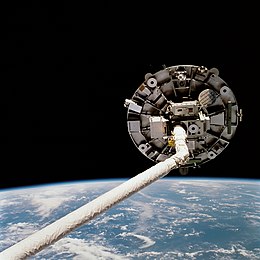 Endeavour's Canadarm grapples the Wake Shield Facility, prior to its deployment | |
| Names | Space Transportation System-69 |
|---|---|
| Mission type | Research |
| Operator | NASA |
| COSPAR ID | 1995-048A |
| SATCAT no. | 23667 |
| Mission duration | 10 days, 20 hours, 29 minutes, 56 seconds |
| Distance travelled | 7,200,000 kilometres (4,500,000 mi) |
| Orbits completed | 171 |
| Spacecraft properties | |
| Spacecraft | Space Shuttle Endeavour |
| Payload mass | 11,499 kg (25,351 lb) |
| Crew | |
| Crew size | 5 |
| Members | |
| Start of mission | |
| Launch date | 7 September 1995, 15:09:00 UTC[1] |
| Launch site | Kennedy, LC-39A |
| End of mission | |
| Landing date | 18 September 1995, 11:38:56 UTC[1] |
| Landing site | Kennedy, SLF Runway 33 |
| Orbital parameters | |
| Reference system | Geocentric |
| Regime | Low Earth |
| Perigee altitude | 321 kilometres (199 mi) |
| Apogee altitude | 321 kilometres (199 mi) |
| Inclination | 28.4 degrees |
| Period | 91.4 min |
 STS-69 mission patch  Left to right – Seated: Cockrell, Walker; Standing: Gernhardt, Newman, Voss | |
STS-69 was a Space Shuttle Endeavour mission, and the second flight of the Wake Shield Facility (WSF).[2] The mission launched from Kennedy Space Center, Florida on 7 September 1995. It was the 100th successful crewed NASA spaceflight[citation needed], not including X-15 flights.
- ^ a b Swan, Bobbie Gail; Harsh, George; Ong, A. Y.; Albjerg, M.; Burns, F. T. Jr. (1 December 1995). "STS-69 Space Shuttle Mission Report" (PDF). NTRS - NASA Technical Reports Server. Houston, Texas: NASA. Archived (PDF) from the original on 25 April 2021. Retrieved 25 April 2021.
- ^ Ryba, Jeanne (1 April 2010). "STS-69". Space Shuttle. Archived from the original on 25 April 2021. Retrieved 25 April 2021.